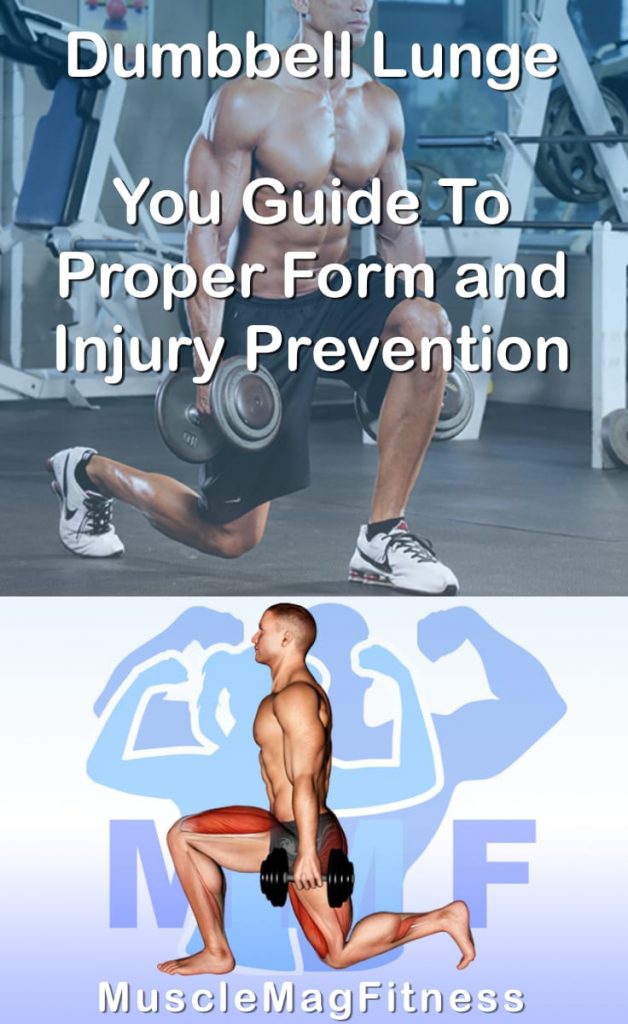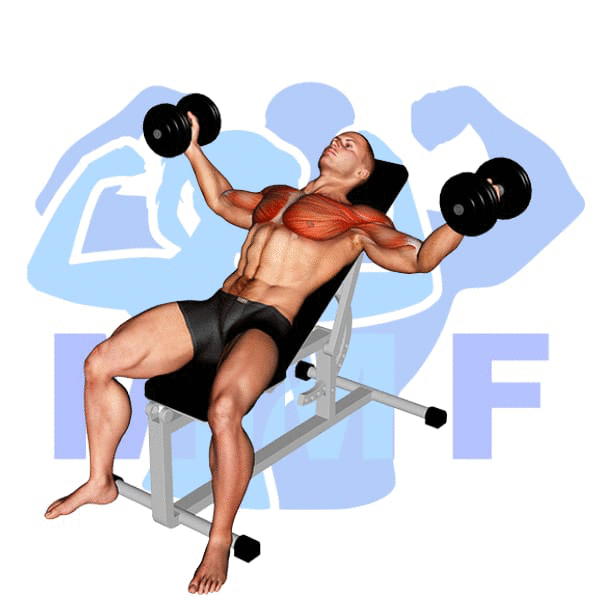Are you struggling with maintaining proper form while performing a dumbbell lunge? You are not alone. One of the most common mistakes people make during this exercise is not keeping their core engaged and their shoulders pulled back. Tight hip flexors can make it even more challenging for you to keep your chest up and maintain proper posture. But don’t worry; we have got you covered. In this post, we will be discussing some tips and tricks to help you perfect your dumbbell lunge form so you can get the most out of this functional movement.
Dumbbell Lunge Summary
- Primary Muscles: Gluteus Maximus
- Secondary Muscles: Adductor Magnus, Quadriceps, and Soleus
- Equipment: Dumbbells
- Mechanics Type: Compound
- Force: Push
- Utility: Basic or Auxiliary

Dumbbell Lunge Instructions
- You will want to start by picking up your dumbbells, one in each hand.
- Now, starting from standing straight up, step out with one leg about one and a half your normal walking step length.
- Next, lunge down by simultaneously bending both legs bringing your back kneed close to but not touching the ground under your body.
- Then, press back up and push your self back to a standing position by stepping back with your front leg.
- You can alternate legs with each set and continue to obtain your desirable total reps, make sure you work each side equally.
Video Tutorial
Dumbbell Lunge Muscles
Target (Agonist)
Synergists
- Adductor Magnus
- Quadriceps
- Soleus
Dynamic Stabilizers
Stabilizers
- Erector Spinae
- Gluteus Medius
- Gluteus Minimus
- Levator Scapulae
- Obliques
- Quadratus Lumborum
- Tibialis Anterior
- Trapezius – Middle
- Trapezius – Upper
Antagonist Stabilizers
- None

Benefits of Dumbbell Lunge
The Dumbbell Lunge is an excellent exercise to include in any strength training or fitness routine. It works the muscles in the lower body, particularly the Gluteus Maximus, which is one of the main muscles responsible for hip extension and abduction. This exercise helps to increase strength, balance, and stability while also improving coordination and mobility. Additionally, the Dumbbell Lunge helps to improve muscular endurance, as it requires a large amount of repetitions to feel the effects. As a result, this exercise can help to reduce fatigue and improve overall performance in any physical activity.
Tips for Performing Dumbbell Lunge
When you need to enjoy the best gains, you must implement these simple tips. Equally important, whenever you would like to protect yourself against an injury, you ought understand these tips.
- Vary Your Training Sets Randomly With Varied Weight And Repetition Combos. For instance set of 5 of 5 for a week or two, then 3 sets of 8-20 reps for a few weeks.
- Carry Out A Good Warm Up Prior To You Start Adding Any Heavy Weight. Not appropriately doing a warmup executing a proper warm up is the most likely cause of injuries.
- Perform Power Sets. Is performing a set of a couple of totally different lifts consecutive. Generally there are a couple key options to accomplish power sets, first is to concentrate on a single muscle. The other is to emphasis on the opposite muscle groups.
- Lift To Close To Failing To Help You Improve The Breakdown Of Your Muscular Tissues. Ensure that you have put in place adequate safety precautions when you’re pushing yourself to near failure.
Benefits and Tips Video
Frequent Mistakes To Avoid
You will need to stay clear of these fairly typical errors to support ideal technique and see rapid gains. Also, when you prevent these issues you will minimize the opportunity of developing an injury.
- Try Not To Miss Recovery Times. Overtraining could in fact help make you weakened instead of bigger.
- You Must Not Execute The Exact Same Exercises Each Occasion. Whenever you execute the exact exercise every training session ones muscular tissues is likely to be trained to undertake that single exercise effectively, but you will plateau faster.
- You’ll Do Better To Not Bypass A Warm-Up. Warming up your Muscle tissue is the Best way to prevent injury.
Find More Dumbbell Exercises Here
Variations and Complementary Exercises
If you’re looking to change up your workout routine and diversify your exercise selection, there are several variations, complementary, or alternative exercises for the exercise Dumbbell Lunge that work similar muscles. Below are some of the most popular options:
Dumbbell Rear Lunge

The Dumbbell Rear Lunge is a great complementary or alternative exercise to the Dumbbell Lunge. This exercise targets the glutes and hamstrings while also working on balance and stability. The movement is performed by standing with feet shoulder-width apart, holding a dumbbell in each hand, and stepping backward with one foot while bending the knees to lower your body. As you come back up, press through the heel of the front foot to return to the starting position. This exercise is a great way to add variety to your workout while still targeting the same muscles as the Dumbbell Lunge.
Dumbbell Walking Lunges

Dumbbell Walking Lunges is a great complement or alternative to the Dumbbell Lunge. This exercise works the same muscles as a standard Dumbbell Lunge, but instead of standing stationary, you take a step forward with one leg and then lunge down, keeping your back straight and your chest up. As you rise, you bring your back leg forward and step with it, alternating legs with each step. This exercise allows for a greater range of motion and more cardiovascular benefits than the stationary version.
Lunge

Lunge is a great alternative or complementary exercise to the Dumbbell Lunge. It is a unilateral exercise which helps to build strength and stability in the legs. Lunge involves stepping forward with one leg and bending both knees until your rear knee nearly touches the ground. It is an excellent exercise for strengthening the core and lower body muscles, while also helping to improve balance and coordination. It is a great way to challenge your body and take your workout to the next level.
Check Out These Top Dumbbell Exercises
Rear Lunge
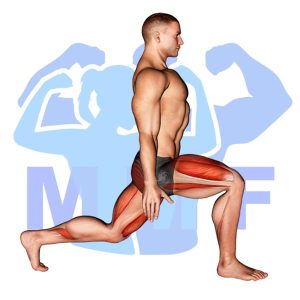
Rear Lunge is a great complementary or alternative exercise to Dumbbell Lunge. It works similar muscle groups, but emphasizes different ones. The Rear Lunge targets the glutes, hamstrings and quads more than the Dumbbell Lunge. To perform a Rear Lunge, stand with feet hip-width apart, then step one leg back, bending the knee and keeping your torso upright. Lower your back knee towards the ground until it almost touches the floor, and then drive back up through the heel of your front foot to return to the starting position. This exercise is great for increasing strength and stability in your lower body muscles.
Walking Lunge
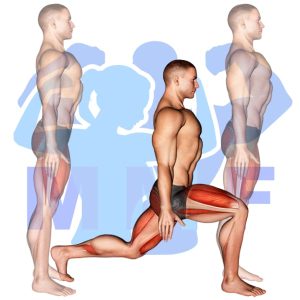
Walking Lunge is a great complementary or alternative exercise to the Dumbbell Lunge. This exercise works the same muscles, but also adds a cardio component as you move from one lunge to the next. It requires more balance and coordination than Dumbbell Lunges, as you are constantly shifting your weight from one foot to the other. Walking Lunges are an effective way to add intensity to your workout and challenge your core stability, balance, and endurance.
Barbell Forward Lunge

The Barbell Forward Lunge is an excellent complementary or alternative exercise for Dumbbell Lunges. This exercise works the same muscles as the Dumbbell Lunge, but with the addition of a barbell, it allows for more weight to be used and a greater range of motion. This exercise also helps to improve balance, coordination, and flexibility. The Barbell Forward Lunge requires a strong core and gluteal muscles in order to complete the motion correctly and safely. Additionally, this exercise can be done with either one or two legs at a time, making it a great option for those looking to increase their workout intensity.
Find More Glutes Exercises Here
Opposing Complementary Exercises
In addition to the Dumbbell Lunge, there are other exercises that can help strengthen opposing muscle groups to give your body an overall balanced workout. Here are some exercises that can be used in combination with the Dumbbell Lunge to maximize your workout:
Sled One Leg Hack Squat

The Sled One Leg Hack Squat is a great exercise to complement the Dumbbell Lunge, as it works the opposing muscle group. This exercise targets the quads, hamstrings, and glutes, allowing for an intense lower body workout that can be adjusted to the user’s preference. The Sled One Leg Hack Squat is great for building strength, stability, and balance, while also providing a great cardiovascular workout. As it works the opposite muscle group of the Dumbbell Lunge, this exercise is a great way to ensure that all of the muscles in your lower body are getting worked.
Sled Narrow Stance Hack Squat

The Sled Narrow Stance Hack Squat is a great complement to the Dumbbell Lunge exercise, as it works the opposing muscle groups. The Hack Squat focuses on the quadriceps, glutes, and hamstrings, while the Dumbbell Lunge works the glutes, hamstrings, and calves. Together, these exercises can provide a comprehensive workout that targets both the lower body and core muscles. The Sled Narrow Stance Hack Squat is an excellent way to build strength and power, while the Dumbbell Lunge can help improve balance and coordination. With both exercises working together, athletes can expect to see great gains in their overall performance.
Sled Hack Squat
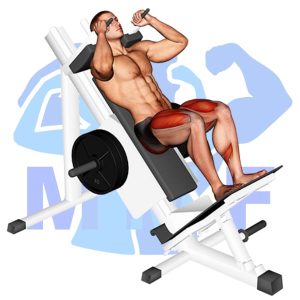
The Sled Hack Squat is a great complementary exercise to the Dumbbell Lunge, as it works the opposing muscle group of the lower body. By doing the Sled Hack Squat, the quads, hamstrings, and glutes are all engaged and strengthened, while the muscles used in the Dumbbell Lunge are stretched and lengthened. This combination allows for greater balance in the lower body, as both exercises help to tone and shape the muscles of the legs.
Transform Your Leg Day with Dumbbell Lunges
If you are looking to switch up your leg day routine, consider adding dumbbell lunges to your workout. This exercise not only targets your quads, hamstrings, and glutes, but also helps improve your balance and stability. By incorporating dumbbells, you can add an extra challenge to your lunges and increase the intensity of the exercise. Plus, since dumbbells are easy to hold and maneuver, you can perform lunges almost anywhere, making it a convenient addition to any fitness routine. Give dumbbell lunges a try and watch as your legs transform into strong and toned muscles.
References: Wikipedia | ExRx.net | PubMed.gov | Comprehensive List of Glutes Dumbbell Exercises
